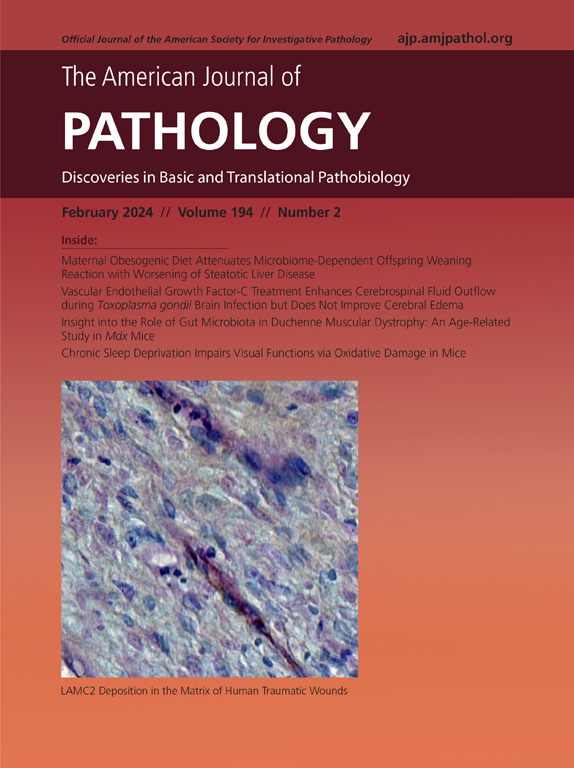AHSA1/Hsp90α Complex Facilitates Microglial Mitophagy by Targeting TOMM70 in Parkinson Disease
IF 3.6
2区 医学
Q1 PATHOLOGY
引用次数: 0
Abstract
Parkinson disease (PD) is a commonly diagnosed neurodegenerative disease with rising prevalence globally. However, the pathology of PD remains largely undefined. The aim of this study was to gain a better understanding of microglial mitophagy in PD. A 1-methyl-1,2,3,6-tetrahydropyidine (MPTP)-induced PD mouse model was established and validated by behavior tests. Western blot and immunofluorescence (IF) analyses showed that autophagy was enhanced in MPTP-induced PD mice. IF, quantitative real-time PCR, Western blot, and co-immunoprecipitation analyses also revealed that silencing of heat shock protein 90α (Hsp90α) protected against mitophagy in PD mice. In the microglia/dopaminergic neuron co-culture system, enzyme-linked immunosorbent assay, transmission electron microscopy, JC-1 staining, measurement of ATP content, Annexin V/propidium iodide and fluorescein isothiocyanate staining showed that lack of Hsp90α in MPTP-treated microglia attenuated dopaminergic neuronal death via suppressing mitophagy. IF staining and co-immunoprecipitation confirmed that Hsp90α formed a complex with activator of Hsp90 ATPase activity 1 (AHSA1), and this complex targeted the mitochondrial molecular switch TOMM70 in microglia. The Hsp90α inhibitor geldanamycin and AHSA1 knockdown further revealed that the AHSA1/Hsp90α complex regulated microglial mitophagy by targeting TOMM70 in MPTP-treated microglia and PD mice. In conclusion, the AHSA1/Hsp90α complex facilitated microglial mitophagy by targeting TOMM70 in PD.
AHSA1/Hsp90α复合物通过靶向TOMM70在帕金森病中促进小胶质细胞自噬。
帕金森病(PD)是一种普遍诊断的神经退行性疾病,全球患病率不断上升。然而,PD的病理在很大程度上仍然不明确。本研究的目的是为了更好地了解PD中的小胶质细胞自噬。建立1-甲基-1,2,3,6-四氢吡啶(MPTP)诱导的PD小鼠模型,并进行行为学实验验证。Western blot和免疫荧光(IF)显示,mptp诱导的PD小鼠自噬增强。IF、qRT-PCR、western blot和共免疫沉淀(co-IP)也显示Hsp90α沉默对PD小鼠的线粒体自噬有保护作用。在小胶质细胞/DA神经元共培养体系中,ELISA测定、透射电镜(TEM)、JC-1染色、ATP含量测定和Annexin V/PI染色表明,mptp处理的小胶质细胞缺乏Hsp90α通过抑制线粒体自噬来减轻DA神经元的死亡。IF染色和协同ip证实Hsp90α与AHSA1形成复合物,该复合物靶向小胶质细胞线粒体分子开关TOMM70。Hsp90α抑制剂格尔达霉素(GA)和AHSA1敲低进一步表明,在mptp处理的小胶质细胞和PD小鼠中,AHSA1/Hsp90α复合物通过靶向TOMM70调节小胶质细胞的线粒体自噬。综上所述,AHSA1/Hsp90α复合物通过靶向TOMM70促进PD中小胶质细胞的自噬。
本文章由计算机程序翻译,如有差异,请以英文原文为准。
求助全文
约1分钟内获得全文
求助全文
来源期刊
CiteScore
11.40
自引率
0.00%
发文量
178
审稿时长
30 days
期刊介绍:
The American Journal of Pathology, official journal of the American Society for Investigative Pathology, published by Elsevier, Inc., seeks high-quality original research reports, reviews, and commentaries related to the molecular and cellular basis of disease. The editors will consider basic, translational, and clinical investigations that directly address mechanisms of pathogenesis or provide a foundation for future mechanistic inquiries. Examples of such foundational investigations include data mining, identification of biomarkers, molecular pathology, and discovery research. Foundational studies that incorporate deep learning and artificial intelligence are also welcome. High priority is given to studies of human disease and relevant experimental models using molecular, cellular, and organismal approaches.

 求助内容:
求助内容: 应助结果提醒方式:
应助结果提醒方式:


